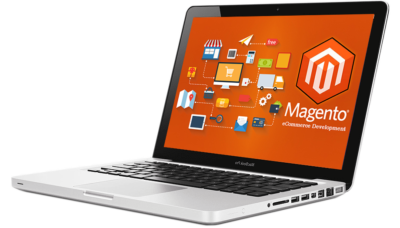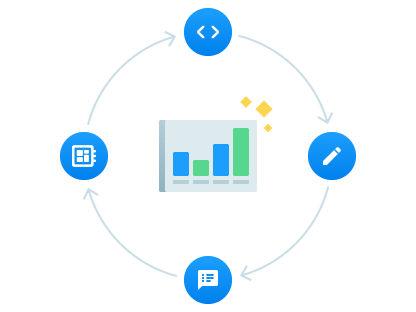Custom Magento Development
Magento 2 Migration
- All the essential data transferred and kept
- The previous M1 functionality adapted to M2
- Multiple tests & bug fixes (if any)

Should You Migrate to Magento 2?
Magento team provides software support to M1 only until June 2020. After End of Life, stores running on the old version will be at high risk. There will be no new features, patches, quality and security fixes. It all jeopardizes the security of customer data. The problems go even further:
- PCI compliance checks will become impossible to pass.
- Data compromise will be a constant threat.
- Slow speed and high time of page load will continue to decrease store conversion rate.
- Magento development companies won’t release updates for their M1 modules.
- You won’t be able to find companies specializing in Magento 1 development.
In contrast, Magento 2 expands the limits of its predecessor significantly, having a better code stack and development environment.

What are the Pros of Magento 2 Migration?

1. M2 is more secure for running a business
M1 hasn’t been updated for years. Patches are the only things that are still released but only for fixing really huge and troublesome security vulnerabilities. Soon the Magento team will stop working on patches for M1 and merchants will remain face-to-face with hackers. These black hats violate website security and steal customers’ personal data such as credit card numbers, passwords, emails, etc. The conclusion is very simple: it’s time to move further and upgrade to M2 to keep your business safe. Even Magento, Visa, PayPal, and the FBI recommend migrating as soon as possible.
2. Magento 2 online stores load much faster
While running a great advertising campaign, doing some SEO magic, or during rush hours, you notice slowdown or broken pages on M1. It turns your efforts into dust and optimization of the existing website is no longer a cure. Thanks to the FPC (full-page caching) technology on Magento 2, page loading is on average 20% faster. Up-to-date and scalable modular architecture decreases time of website load speed and server response to users’ actions such as checkout, adding products to a shopping cart, etc.


3. The abundance of functionality improves UX
Magento 1 is limited but your business vision shouldn’t be. The platform can’t put into effect your brightest fresh ideas especially related to customer acquisition or performance boosting. Unlike M1, its successor offers a built-in 2-step streamlined checkout to make the purchasing process more convenient and faster. The Instant Purchase feature also allows you to previously save payment and shipping information of your customers. When they come back to your shop, you simply offer them to skip checkout and go to a confirmation page.
4. Development and maintenance with no damage
Spending tons of money on optimization, code-fixing, or redesign doesn’t bring fruits anymore on M1. When you face this, it’s time to put doubts aside and migrate to Magento 2. Its modular code base allows reducing development cycles, utilizing a wider toolset, and performing various integrations as easy as never before. The simplicity of the development process within Magento 2 helps to customize specific parts of a website with no damage to others.


5. Mobile friendly webstores. As never before!
Keeping up with trends, Magento released its Progressive Web Apps Studio which applies cutting-edge approaches and design patterns to develop appealing storefronts for Magento 2. Now online stores have a responsive design which creates great app-like and smooth user experience in browsers across all mobile devices. Applying PWA to your website, you avoid wasting extra time and money on the development of separate apps for Google Play or App Store. There are no such updates for Magneto 2, so it can’t offer optimal performance and seamless work on all devices.
6. Simply the best eCommerce solution on the market
If you are a tech-savvy and results-oriented person there is no reason to still use Magento 1. In fact, M2 admin panel allows managing its core features, list new products and find other tools even without developers’ help. The navigation within the panel is extremely simple and clear because major categories are divided into multiple subcategories. To sum up, M2 has more features, excellent B2B user experience, upgraded technology stack, and many other benefits.

How does the Magento 2 Migration Process Look Like?
But don’t be scared as we will help you to:
1: Collect and Adapt Extensions.
2: Prepare Your Store for Migration.
3: Use Data Migration Tool.
4: Change the Migrated Data.
5: Transfer M1 Theme and Images.
6: Select New Extensions.
7: Perform Testing and Fix Bugs.
8: Transfer Incremental Data.
9: Launch of Your Upgraded Store.
10: Support after Store Launch.

Why Choose Our Magento Migration Services?
We started developing websites on M2 more than 5 years ago, back when it was in a beta version. Since then, our team has already migrated dozens of online stores from Magento 1 to Magento 2.
We know all migration steps and procedures, all obstacles and possible errors on the way. Therefore, we have developed ready-made solutions and created custom scripts to help overcome these pitfalls on the spot.
There are some more facts that make our team a perfect fit for your eCommerce business. Our key advantages are 11+ years of experience with Magento and 1000+ successfully developed projects. We specialize in this platform only and know it like the back of our hands. As a result, the majority of our clients stay with us for 2+ years. That impresses and motivates us to strive for exceptional results for the companies we are working with.




